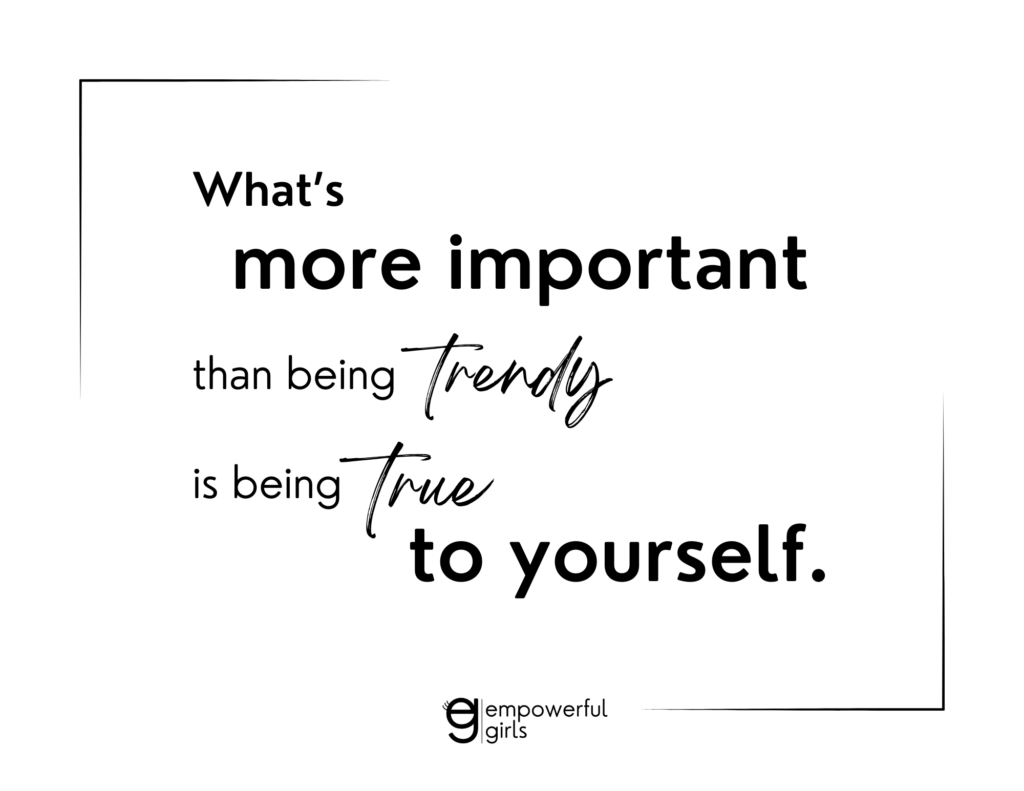
What’s Trending
Let’s talk about trends. What trends are you into right now? Lately I’ve been liking the oversized fit for hoodies and sweatshirts–they’re so comfy. I’ve also seen the return of Y2K style with baby tees, butterfly clips, wide leg pants, Doc Martens–these were all trending when I was a tween and teen so it’s amusing to see them resurface. Trends can be fun, they fit a variety of people’s tastes, and their lifespan is on average less than a year. There are some troubles with trends though. And while I’m not trying to convince you to reject all trends in the future, there are some things to keep in mind that will help you navigate trends.
Fitting In
While something is trending, we might feel social pressure to get it or have it or wear it or do it, thinking it will make others see US as trendy, hopefully improving our social status. It’s natural to want to be liked and fit in. Feeling a sense of belonging within a group is especially important during your tween and teen years. And when we see others who are on-trend have this thing in common and even group together, we want to feel included too, so we think we have to get in on the trend to get in with the group.
Being Excluded
This stems from a fear of the consequence of not being on trend, the opposite of fitting in: we could be excluded. No one wants to feel rejection or be seen as uncool. I mentioned this in episode 57, The Problem with Popular. People have an inherent need to be accepted by others–a hardwired survival instinct from the Stone Age when your life depended on not getting excluded from your clan or else the sabretooth tigers would get you. This need for being included is still vital today, and often our decisions are based on social consequences. Unfortunately girls in particular tend to ostracize other girls for their looks or style. I recently saw a video of a mom whose daughter was teased by classmates because she didn’t have an actual Stanley Cup. That’s not cool. Putting others down–for any reason–does not put you up. Especially if it’s regarding a trend, that’ll only exacerbate the issue of people chasing trends for fear of rejection.
Validation + Sense of Self
If you only want to get in on a trend to fit in so you won’t be excluded, that’s a sign of needing external validation, wanting approval from others. This is connected to having a reflected sense of self, basing your value and worth on how others see you. Over the years I’ve jumped on some trends, and at one point I was convinced that if I bought certain brands, clothing styles, even a specific pair of earrings, those would make other people like me better. Spoiler alert: it didn’t. Neither earrings nor Stanley Cups will bring you true belonging. Instead, work toward having a solid sense of self through internal validation. Get to know yourself, explore your interests, recognize your individuality, and express your style. Rather than trying to be who you think others will like more, embrace and be who YOU are. You don’t need to be anybody else; you are the only one like you–own it. And naturally, others who appreciate your authenticity will gravitate toward you.
Constantly changing
Here’s another trouble. Trends tend to come and go in cycles: some thing–a product or brand or style–rises quickly in popularity, and then not long after, the trend falls (sometimes just as swiftly as it rose) as the next up and coming thing takes its place. Trying to keep up with trends is like running a race, and as soon as you reach the finish line, you have to go run another race, and you do that one but there’s another right after, and you just keep chasing finish lines. It’s hard to keep up with trends, let alone keep track of them.
Impossible Standards
As trends shift, so do beauty standards. Not only are they always unrealistically high, they’re also impossible to reach because they keep changing. In just my lifetime, the “perfect” body shape has gone from tall and athletic in the 80s, to extremely thin in the 90s, to “healthy” skinny in the early 2000s, to an accentuated hourglass figure in recent years. Face feature trends have changed drastically too: eyebrow shape, skintone, cheekbones, lip fullness. It’s ridiculous that the finish lines keep moving and it’s impossible to keep up with them.
Expensive
Also because trends are constantly changing, trying to stay on trend can be expensive. Not long after spending money on one trend, here comes another one you feel obligated to shell out more money for so you can try to keep up with all the trends. Every season there’s a new IT product people think they have to have. Like shoes for example–Crocs, UGGs, Dunks–that adds up. When you move on from the old trend and throw it out, it’s almost like you’re also throwing money away, like that emoji of cash with wings flying off. This also makes us value material things more than what matters most.
Environmental impact
There’s another cost to trends–in addition to money, there’s an environmental cost. By their very nature, fast fashion trends come and go quickly. The United Nations Environment Programme stated that people are buying more clothes and wearing them for less time before discarding them, and this creates an excess of clothing waste in landfills. Also Princeton University reported that manufacturing fast fashion clothes also wastes more water, plus toxic dye (like color) chemicals and microplastics end up in oceans, and toxic gasses are released into the air when the excess clothes in landfills are incinerated (burned). This next statement surprised me, “The fashion industry is currently responsible for more annual carbon emissions than all international flights and maritime shipping combined.” That’s on the manufacturers, they need to be way more responsible, environmentally conscious, and shift to sustainable fashion. We should send them that message both through our words and also our money–by not bouncing from trend to trend and buying items so quickly.
Influencers =/= Experts
One last thing to keep in mind: most influencers are not experts. If there is a trend they are pushing that involves nutrition, fitness, health care, or skin care–things that would impact your body–you need to be very cautious. Influencers share about products to make money. Just because they’re famous, or a celebrity’s daughter, or have an enormous amount of followers does not mean they know what they’re talking about or if it’s right for you. You don’t need to go on a Sephora shopping spree for a 10-step skincare routine because you saw some girl do it–you need expert advice from a dermatologist (a skin doctor). They recommend tweens use a gentle cleanser, moisturizer, and sunscreen; that’s it. For teen acne concerns, products with salicylic acid, benzoyl peroxide or retinoids can help, HOWEVER, it’s best to get evaluated by a dermatologist to know what’s right for you. Many skin care products at beauty supply stores contain ingredients that are not for your young skin, and can actually give you more skin issues. Whatever the trend may be, if it impacts your body, ask the experts.
Be True to Yourself
Again, I’m not trying to convince you to abandon all trends; they’re a part of life so I want you to be more mindful about them–about the trend choices you make, the reasons you make them, and the impact. Having a broader perspective toward trends will help you strengthen your own sense of self, develop critical thinking skills, and not get caught up constantly chasing after them. You can keep trying out trends to see if they’re a good fit for you. What’s more important than being on trend is being true to yourself.
Trends Poster Printable
I created an “Trends” poster for you to print out, personalize, and post on your wall where you’ll see it, remember it, practice it, and believe it — that’s the important part.
Resources
If you have a topic suggestion, I’d love to hear from you! Send an email (tweens get the OK from your parents) to hello@EmpowerfulGirls.com .
If you have social media already, follow me on Insta or tiktok @empowerfulgirls. I’m not encouraging or endorsing social media, but I’m on there to offer an unfiltered, uplifting alternative to what’s in your feed. Remember to get on the email list for the newsletter!
